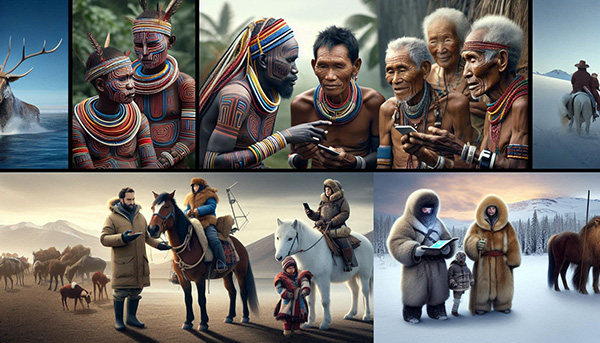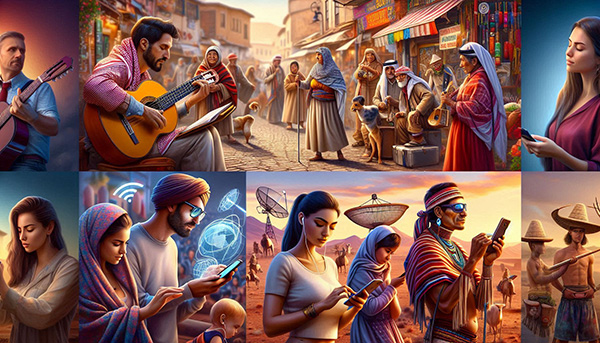By: John S. Morlu II, CPA
While tech companies are busy arguing about dark mode versus light mode, the rest of the world is speaking in languages they’ve never heard of—*fluently*. Global tribes have been building communities, trading, innovating, and adapting long before the first Silicon Valley hoodie was ever zipped.
If your product doesn’t know what a Fulani market day looks like or how Mandingo/Mandinka (approx. 11 million) traders negotiate across three borders, you’re not building global tech—you’re just building a local app with Wi-Fi privilege.
1. The Tribe Test: Bigger Than Countries
You want scale? Start with tribes.
Let’s begin with the Hausa (approx. 100 million)—nearly 100 million strong, stretching across Nigeria, Niger, Ghana, Cameroon, Benin, and even parts of Sudan. They’re traders, educators, and cultural influencers with a communication system stronger than most satellite networks (also known as WhatsApp and word of mouth). If your product can win in Zaria and work its way through Kano, Niamey, and Garoua—it’s ready for the big leagues.
Then there’s the Mandingo/Mandinka (approx. 11 million) (Mandinka, Mandiga—depends on who’s translating). Spread across Mali, Guinea, Gambia, Senegal, and Côte d’Ivoire, they’ve built trade routes and trust networks stronger than blockchain since the days of the Mali Empire. You think Stripe is innovative? The Mandingo/Mandinka (approx. 11 million) were running cross-border credit lines on verbal agreements before Western Union was born.
And don’t forget the Fulahs/Fulani (approx. 40 million) (or Fulani or Peul)—the nomadic business class of West and Central Africa. From Nigeria to Guinea to Chad to Cameroon to Mauritania, they move, adapt, and transact with the efficiency of a decentralized app—only faster, and with better food.
2. Tribal Networks Are Global Before Tech Was
Fun Fact: The Tuareg camel caravans once ran “logistics” across the Sahara better than FedEx. Meanwhile, in Southeast Asia, the Hmong (approx. 4.5 million) communities stretch across Vietnam, Laos, Thailand, and China. And the Pashtun (approx. 50 million)—yes, the same ones you’ve seen on the news—exist across Afghanistan and Pakistan in a tribal structure that confuses GPS but works flawlessly in real life.
And in Latin America? Don’t sleep on the Quechua (approx. 10 million) and Aymara (approx. 2 million) communities, spanning Peru, Bolivia, Ecuador, and Chile—speaking their own languages, growing high-altitude crops, and now using smartphones to access market prices and weather alerts.
So the next time someone says, “We’re building for Africa,” ask them which tribe. Because “Africa” isn’t one country—and neither is Asia, or Latin America. But tribes? They’re the real power blocks.
3. Want Real Virality? Win the Village First
A TikTok trend can last 72 hours. But impress an Ashanti matriarch or a Hausa (approx. 100 million) market queen? She’ll make your app go viral on five continents through cousins, nephews, and neighbors.
Pro Tip: If you want to scale like wildfire, build something that solves a local pain point for a tribe that spans countries. Because tribes don’t stop at customs checkpoints.
4. Build for Tribe Logic, Not Silicon Logic
- People want audio prompts in their native language—not dropdown menus in broken English.
- They want pricing in daily chunks, not monthly subscriptions.
- They want tools that respect communal sharing (one phone, five users), not one-login-per-device rigidity.
You know who gets this? The tribes. They’ve been building scalable systems on oral tradition, trust, and reputation for centuries.
Fun Tidbit: In many Fulani communities, borrowing cattle without asking is normal—as long as you return it with interest (i.e., more cattle). Try that with a startup.
5. More Tribes, More Lessons (and Laughs)
Let’s take a quick global tour of smart, resourceful people big tech often forgets:
In Ethiopia, the Oromo (approx. 35 million) people are one of the largest ethnic groups in Africa. They’ve been sharing news, settling disputes, and making business decisions using a traditional democratic system called Gadaa—long before your startup added “decentralized governance” to its pitch deck.
In Indonesia, the Javanese (approx. 85 million) number over 80 million. You might not know them, but they could teach your customer service team a thing or two about patience, politeness, and how to get things done without yelling into the phone.
In Papua New Guinea, there are over 800 tribes—yes, 800! Each with its own language. Imagine launching your app there. Now imagine needing 800 translations. Or better yet, just make your app so simple that no one even needs words.
Fun Fact: In rural Mongolia, herders still use horses, but they’ve also adopted solar chargers and smartphones. One moment you’re riding through the steppe, the next you’re getting a WeChat payment request.
Let’s not forget the Inuit (approx. 180,000) communities of Canada and Greenland. They’ve been navigating icy terrain, managing community trade, and surviving with tech made from bone and snow. Now they use satellite phones, GPS, and radio to organize hunting trips. If they can adapt—so can your app.
6. Don’t Build Apps for Boardrooms—Build for Real Rooms
Some people build apps in glass offices. Others use apps in mud huts, small shops, fishing boats, and open-air markets.
- Can your app load faster than a goat can walk away with a bag of cassava?
- Can it work on a cracked phone screen with 12% battery in the sun?
- Can grandma figure it out without asking her 12-year-old grandson?
If not, it’s back to the drawing board.
Humor Tip: If your app only works in San Francisco coffee shops, it might not be saving the world—just latte loyalty points.
7. Tribes Closer to Home (Yes, Even in Europe and America!)
Let’s stop pretending tribes only exist in jungles and deserts. They’re everywhere—even wearing jeans and sipping espressos.
In Eastern Europe, the Roma/Gypsy (approx. 10–12 million)— people span across Hungary, Romania, Bulgaria, and the Balkans. For centuries, they’ve traded goods, told stories, and survived with resilience and strong social networks. They’ve even taken their craft and culture to Spain, giving the world flamenco—yes, thank a tribe for that.
In Western Europe, the Bretons (approx. 2 million) in France and Basques (approx. 3 million) in Spain and France have their own languages, traditions, and strong community ties. The Basques (approx. 3 million) even developed their own tech-supported cooperative businesses. Who said tribes can’t innovate?
Over in the Middle East, the Bedouin (approx. 4 million) tribes still maintain powerful nomadic traditions across Saudi Arabia, Jordan, and Syria. They can navigate deserts better than your GPS, host guests with legendary hospitality, and pass messages through networks that no algorithm can track.
And don’t forget the Kurds (approx. 35-40 million), spanning Turkey, Iraq, Iran, and Syria—fierce in culture, proud in identity, and masters of cross-border living. You want to test your product’s mobility? Try winning over a Kurdish trader who sells goods across four countries without a PowerPoint presentation.
Now to North America—tribes here aren’t just historical footnotes. The Navajo Nation (approx. 400,000) Nation in the U.S. spans multiple states and has launched its own internet initiatives. Native American communities are blending tradition with modern tech to preserve languages and manage resources.
In South America, the Guarani (approx. 5 million) people live across Paraguay, Brazil, and Bolivia. They practice community-based living and agriculture—and yes, they’re using smartphones and apps too (if they work offline, that is).
Fun Fact: In some Andean villages, farmers still use messages called chaskis (runners who deliver info by foot), but now they also use WhatsApp to send photos of sick alpacas to the vet.
The point? Tribes are everywhere. And no matter the language, clothing, or climate, they all want tech that respects their ways—not something that demands a user manual thicker than a Bible.
Final Thought: Build Like Tribes Move
Tribes don’t ask for passports. They don’t wait for permission. They move with purpose, trade with trust, and spread innovation faster than your launch video on Instagram.
So don’t just build for pitch decks—build for real people:
The lady in Uganda selling roasted plantains and tracking credit in her head.
The Maasai herder using solar power to charge a phone under a tree.
The Sami reindeer farmer who checks the weather with both the sky and a smartphone.
These people don’t need fancy—they need functional.
The world isn’t divided by borders. It’s connected by people. Tribes were the original cross-border networks—long before Amazon, Alibaba, or AirDrop.
So don’t just ask:
“Is it scalable?”
Ask:
“Can it move like the Fulah?”
“Can it adapt like the Mandingo/Mandinka (approx. 11 million)?”
“Can it negotiate like the Hausa (approx. 100 million)?”
“Can it echo across mountains like the Quechua (approx. 10 million)?”
If yes—then you didn’t just build a product.
You built a movement.
Author: John S. Morlu II, CPA is CEO & Chief Strategist of JS Morlu, a Virginia-based CPA firm with growing global operations and a mission to build smart tech for underserved markets. The company’s product line includes:
• www.recksoft.com
• www.fixaars.com
• www.finovatepro.com
JS Morlu LLC is a top-tier accounting firm based in Woodbridge, Virginia, with a team of highly experienced and qualified CPAs and business advisors. We are dedicated to providing comprehensive accounting, tax, and business advisory services to clients throughout the Washington, D.C. Metro Area and the surrounding regions. With over a decade of experience, we have cultivated a deep understanding of our clients’ needs and aspirations. We recognize that our clients seek more than just value-added accounting services; they seek a trusted partner who can guide them towards achieving their business goals and personal financial well-being.
Talk to us || What our clients says about us






